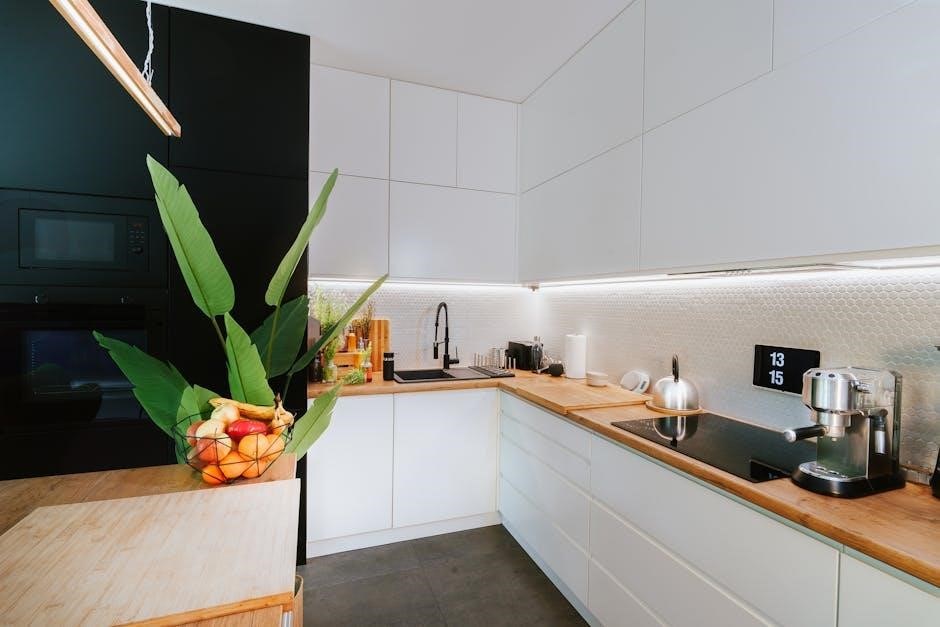Yale Real Living Manual: A Comprehensive Guide
Welcome! This comprehensive guide provides an overview of Yale Real Living products, focusing on electronic door locks designed for residential use. It encompasses installation, programming, and troubleshooting tips, drawing from official Yale documentation to ensure users can effectively secure and manage their homes with ease.
Overview of Yale Real Living Products
Yale Real Living products represent a modern approach to home security, offering a blend of convenience, control, and connectivity. Engineered for easy installation and integration, these products often fit standard deadbolt lock door preparations, aligning with ANSI/BHMA A156.115 standards. The lineup includes key-free touchscreen deadbolts, leveraging Z-Wave Plus technology for seamless integration into home automation and security systems.
Users gain the ability to remotely lock and unlock doors, create pin codes, view access history, and receive notifications from virtually anywhere. Yale Real Living locks are designed to be tamper-resistant, enhancing overall security. Furthermore, these products emphasize user-friendliness, ensuring that homeowners can easily manage access and customize security settings. The integration with Z-Wave technology typically requires the lock to be within a specified range of another network controller or repeating device, influenced by environmental factors.
Yale Real Living is committed to safety and ease of use; Yale offers comprehensive documentation and support, including installation instructions and programming guides, accessible online. These resources cater to both novice and experienced users, ensuring a smooth setup and optimal performance. With a focus on innovation and user-centric design, Yale Real Living products aim to provide peace of mind.
Key Features and Benefits of Yale Real Living Locks
Yale Real Living locks offer a suite of features designed to enhance home security and convenience. Keyless entry is a primary benefit, allowing homeowners to unlock their doors using pin codes or smartphone integration, eliminating the need for physical keys. This feature is particularly useful for families and individuals seeking to streamline access management. The integration of Z-Wave technology provides remote control capabilities, enabling users to lock and unlock doors from anywhere via a connected device.
Access history tracking offers a detailed log of who has entered the home and when, boosting security awareness. Customizable pin codes allow for granting temporary or permanent access to guests, service providers, or family members. Tamper resistance is a crucial security feature, protecting the lock from unauthorized access attempts. Furthermore, the locks are designed for easy installation, fitting standard door preparations and minimizing the need for professional assistance.
Notifications alert homeowners of lock activity, such as when the door is locked or unlocked, enhancing real-time security monitoring. Battery-powered operation ensures continued functionality during power outages, adding an extra layer of reliability. Yale Real Living locks combine robust security features with user-friendly technology, delivering a comprehensive solution for modern home security needs, backed by Yale’s long-standing reputation for quality and innovation.
Yale Real Living Models: YRD216, YRD156, and YRD620
The Yale Real Living series includes several models, each designed with specific features to cater to various user needs. The YRD216 is a key-free touchscreen deadbolt, providing secure access via pin codes. It eliminates the need for physical keys, offering a streamlined and modern entry solution. Installation is straightforward, fitting standard door preparations for easy setup.
The YRD156, another key-free touchscreen deadbolt, integrates Z-Wave Plus technology, allowing seamless integration with home automation and security systems. This model enables remote locking and unlocking, pin code creation, access history viewing, and notifications through connected devices. Its tamper-resistant design further enhances security.
The YRD620 offers similar functionalities with potential variations in design or specific features, ensuring a comprehensive range of choices to meet diverse preferences. Each model is engineered for quick and easy installation, maintaining Yale’s commitment to user-friendly security solutions. These locks enhance home security and convenience, backed by Yale’s reputation for quality and innovation. The variety ensures that customers can select the perfect lock to fit their specific needs and integrate seamlessly into their smart home ecosystems.
Installation Instructions: A Step-by-Step Guide
Installing your Yale Real Living lock is designed to be a straightforward process. Begin by preparing your door, ensuring it meets standard deadbolt lock door preparation specifications (ANSI/BHMA A156.115). Remove any existing deadbolt hardware. Next, install the latch and strike plate, ensuring they are correctly aligned for smooth operation. Adjust the latch position to either 2-3/8″ or 2-3/4″ as needed.
Attach the exterior touchscreen escutcheon to the door, followed by the interior mounting plate. Connect the necessary wires, ensuring proper alignment and secure connections. Install the interior escutcheon assembly onto the mounting plate. Secure all components with the provided screws, typically a combination of wood and machine screws.
For network-enabled models, install the optional network module, ensuring batteries are removed beforehand. The lock automatically adjusts for proper handing. Replace the cover and tighten the screw to secure it. Finally, test the lock to ensure it functions correctly. Refer to the detailed diagrams and instructions included with your specific model for visual guidance and troubleshooting tips. This step-by-step approach ensures a secure and functional installation.
Programming Instructions: Customizing Your Lock
Customizing your Yale Real Living lock involves programming user codes and adjusting settings to fit your security needs. Begin by activating the touchscreen by touching it with the back of your hand. Enter the Master PIN code, followed by the gear icon, to access the programming menu. From here, you can add new user codes, delete existing ones, or modify lock settings.

To add a user code, navigate to the “Add User” option, enter a unique 4 to 8-digit code, and press the gear icon to save. You can set specific schedules or restrictions for each user code, granting temporary access or limiting entry times. To delete a user code, select the “Delete User” option, enter the code you wish to remove, and confirm the deletion.
Explore other programming features such as auto-relock time, volume control, and lock-out mode. Lock-out mode disables all user codes, providing an extra layer of security. Remember to keep your Master PIN code secure and change it periodically. For detailed instructions and advanced programming options, consult the product documentation or visit the Yale Real Living website. These customizations enhance the functionality and security of your Yale lock.
Z-Wave Integration and Home Automation Compatibility
Yale Real Living locks with Z-Wave technology offer seamless integration into various home automation and security systems. Z-Wave allows your lock to communicate wirelessly with other smart devices, enabling remote control and monitoring. When connected to a compatible Z-Wave hub, you can lock or unlock your door from anywhere using your smartphone or tablet.
Integration also enables advanced features such as creating personalized entry codes for family members, guests, or service providers, and receiving notifications when the door is locked or unlocked. You can view access history, track who enters and exits your home, and set up custom automation routines. For example, you can create a scene that automatically locks the door, turns off the lights, and arms the security system when you leave.
To integrate your Yale lock with a Z-Wave system, follow the instructions provided by your home automation controller. Typically, this involves putting the controller into inclusion mode and then activating the Z-Wave function on your lock. Ensure your lock is within the recommended range of the controller, usually 30-50 feet, though obstacles can affect signal strength. Regularly check for firmware updates to maintain compatibility and optimize performance.
Troubleshooting Common Issues
Encountering issues with your Yale Real Living lock can be frustrating, but many problems have straightforward solutions. One common issue is the lock not responding to keypad inputs. This can often be resolved by replacing the batteries with fresh ones. Ensure you use the correct type of batteries as specified in the manual.
If the lock is having trouble connecting to your Z-Wave network, verify that it is within the recommended range of your hub or repeater. Obstructions like walls or metal objects can interfere with the signal. Try moving the hub closer to the lock or adding a Z-Wave repeater to extend the network’s range.
Another potential problem is incorrect code entry. Double-check that you are entering the correct user code and that the keypad is clean and responsive. If you suspect a programming issue, consult the manual for instructions on resetting the lock to factory defaults and reprogramming the user codes. For mechanical issues, such as a stiff bolt, ensure the door and frame are properly aligned, and the strike plate is correctly installed. If problems persist, consult Yale’s support resources or a qualified locksmith.
Battery Replacement and Maintenance

Maintaining your Yale Real Living lock involves regular battery replacement to ensure uninterrupted operation. When the low battery indicator appears, promptly replace all batteries with new ones of the recommended type. Mixing old and new batteries or using incorrect types can lead to malfunctions or reduced battery life;
To replace the batteries, typically located on the interior escutcheon, remove the battery cover and replace all the batteries simultaneously. Ensure correct polarity when inserting the new batteries. After replacement, test the lock to confirm it functions correctly.
Beyond battery maintenance, periodically clean the lock’s exterior with a soft, damp cloth. Avoid using harsh chemicals or abrasive cleaners, as they can damage the finish and touchscreen. Inspect the bolt and strike plate for any signs of wear or misalignment, and adjust as needed to ensure smooth operation. In colder climates, consider using lithium batteries for improved performance in low temperatures. Proper maintenance will extend the life of your Yale Real Living lock and maintain its reliability. If you encounter any issues, consult the user manual.

Security Features and Tamper Resistance
Yale Real Living locks are engineered with multiple security features to protect against unauthorized entry and tampering. Keyless entry eliminates the vulnerability of traditional keys, while customizable PIN codes allow homeowners to control access and easily revoke codes when necessary. The touchscreen interface is designed to resist fingerprint buildup, preventing code detection.
Many Yale Real Living models incorporate tamper-resistant features, such as alarms that sound when forced entry is attempted or when the lock is forcibly removed. The locks are constructed with robust materials to withstand physical attacks. Z-Wave integration adds another layer of security, enabling remote monitoring and control, as well as notifications of suspicious activity.
For enhanced protection, consider enabling lockout mode, which disables the touchscreen and prevents unauthorized code entry. Regularly update the lock’s firmware to benefit from the latest security enhancements. By utilizing these features and maintaining vigilance, homeowners can significantly enhance the security of their homes with Yale Real Living locks. Always refer to the product manual for specific security settings and recommendations.
Factory Resetting Your Yale Real Living Lock
Factory resetting your Yale Real Living lock is a process that restores the device to its original default settings. This action erases all user codes, including the Master PIN code, and resets all programming features to their initial configurations. It is typically performed when troubleshooting persistent issues, preparing the lock for a new user, or resolving network connectivity problems.
To initiate a factory reset, first, locate the reset button on the lock’s interior. The location may vary depending on the specific model, so consult your product manual for guidance. Typically, you will need to remove the battery cover to access the reset button. Once located, press and hold the reset button for the duration specified in your manual, usually around 5-10 seconds.
After releasing the button, the lock will indicate the reset process is complete, often through audible beeps or visual cues. Following the reset, you will need to reprogram the lock, including setting up a new Master PIN code and any other desired user codes. Ensure you have your manual handy during this process.
Where to Find Additional Support and Documentation
For comprehensive assistance with your Yale Real Living lock, a variety of resources are available to ensure you can effectively manage and troubleshoot your device. Your primary source of information should be the official Yale Real Living website, accessible via your web browser. Navigate to the “Product Information & Documentation” section for detailed installation instructions, programming guides, and user manuals. These documents are often available in multiple languages, including English and Spanish, to cater to a diverse user base.
Beyond the website, consider exploring online forums and communities dedicated to smart home technology and Yale products. These platforms can provide valuable insights from other users who may have encountered similar issues. Additionally, many retailers who sell Yale Real Living locks offer their own support channels, including FAQs, troubleshooting guides, and customer service representatives.

If you require immediate assistance, contacting Yale’s customer support directly is recommended. Their contact information can typically be found on the Yale Real Living website or in your product documentation. Remember to have your lock’s model number and any relevant details about your issue readily available to expedite the support process.
